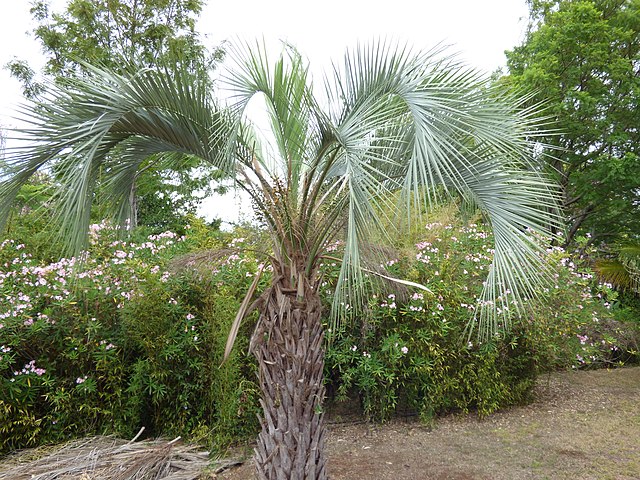
The Pindo palm is known for its tropical look, cold hardiness and tasty fruit. Originally coming from South America, This palm grows yellow fruits in late summer that become ripe by fall. It can handle some cold, but prefers warmer areas, like in zones 8b to 11.
Common Names:
Jelly palm, Wine palm, & Pindo palm.
Scientific Name:
Butia capitata
Origin:
The Pindo palm originally comes from South America, mainly Brazil and Uruguay.
Appearance:
The Pindo palm has green leaves that bend gracefully. It grows clusters of golden-yellow fruits that look pretty and taste good.
Growth Rate:
Moderate growth. It grows at a steady pace, adding about 1 to 2 feet to its height every year.
Max Growth Height:
Pindo palms can get as tall as 20 feet in the best conditions, but most grown at home stay around 12-15 feet tall.
Foliage Spread:
The leaves can spread out 6 to 10 feet wide.
Cold Hardiness and Hardiness Zone:
This palm is okay with some cold, but it’s happiest in warmer places. The Pindo palm thrives in zones 8b to 11, and sustains damage at temperatures below 15°F (-9°C).
Soil Type:
The Pindo palm likes soil that drains well but keeps a little moisture without getting too wet.
Fruit and Flowering:
In late summer, the Pindo palm grows groups of small, golden-yellow fruits that become sweet and ready to eat by fall. The fruit has historically been made into jelly or wine hence the name jelly palm and wine palm.
Can it Grow Indoors:
If you have a big enough container, you can grow it inside. But it needs sunlight to grow well and produce fruit.
Light Requirements:
Partial shade or full sun to grow optimally.
Water Requirements:
Moderate watering to keep the soil moist but not soaked. Too much water can harm its roots over time.
Maintenance Level:
It doesn’t need much trimming. You can occasionally prune dead leaves, but this isn’t necessary. Water it regularly and fertilize your Pindo palm 2-3 times a year with high quality palm fertilizer to help it grow well.
Common Diseases/Pests:
It’s pretty tough against sickness and doesn’t have many threats. It can be susceptible to root rot if overwatered.
Plant Care:
Water your Pindo palm regularly and apply fertilizer 2-3 times per year to help it grow.
Pindo Palm Frequently Asked Questions:
1. Are the fruits of the Pindo palm edible?
Yes, they are! The golden-yellow fruits of the Pindo palm are not only attractive but also tasty and safe for people to eat. You can even try to make jelly from them if you like.
2. What’s the best way to help a Pindo palm produce fruit?
To encourage fruit production, make sure your Pindo palm gets enough sunlight and is fed with the right fertilizer a few times a year. Proper care can help it grow those delicious golden-yellow fruits.
3. How do I protect my Pindo palm during colder weather?
If you’re expecting colder temperatures, you can protect your Pindo palm by covering it with frost cloth during frosty nights. Mulching around the base of the tree can also help retain some warmth in the roots and lower trunk.
4. When is the best time to plant a Pindo palm?
Spring or early Summer is the best time to plant a Pindo palm. Planting during warmer weather allows the tree to establish roots before colder weather sets in.
The Pindo palm is not only a beautiful addition to your tropical landscape but also leaves you with delicious fruit! With a little care, the Pindo palm can become a true gem on your property.
